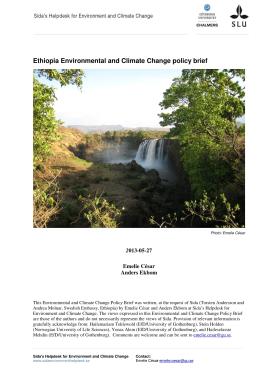Ethiopia Environmental and Climate Change policy brief
Ethiopia Environmental and Climate Change policy brief
During the last couple of years Ethiopia has had a remarkable economic growth (an average of 10%/year) and the country has achieved notable progress towards many of the millennium development goals (MDGs), including those for poverty, access to education and health. Improvements have also been made in basic infrastructure and in strengthening both regional and national policies and governance capacity.
Today over 80 million people live in Ethiopia, and over 80% are living in rural areas. Population growth remains high at 2% and Ethiopia is expected to reach over 120 million people by 20301
Ethiopia’s economy and ecological system are fragile and vulnerable to climate change. Environmental challenges in Ethiopia include climate change, soil degradation, deforestation, loss of biodiversity and ecosystem services, and pollution of land, air and water. Ethiopia’s economy is also highly dependent on natural resources. Exploitation of these natural resources may generate large economic benefits in the short term. However, in the long term unsustainable use of these natural resources increases not only environmental degradation, but decreases economic growth and livelihood opportunities.

